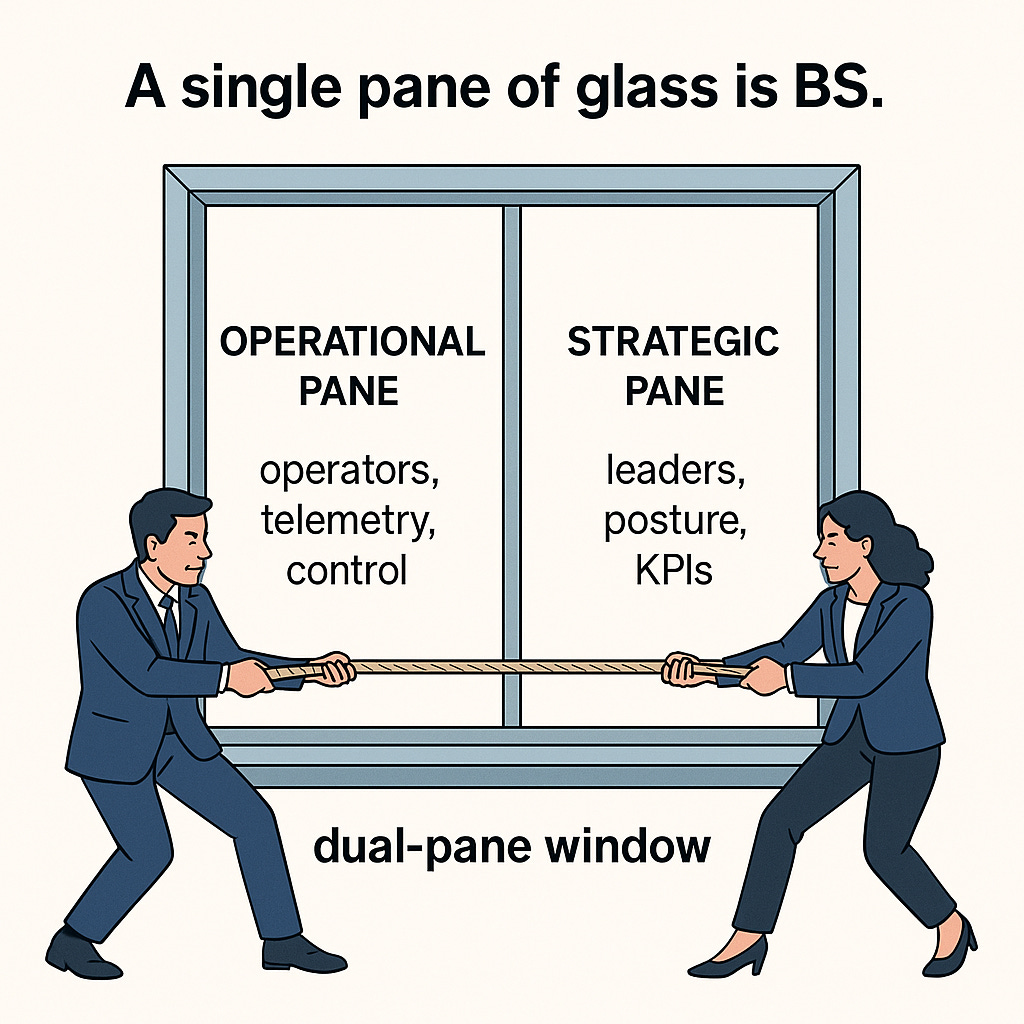The Dual-Pane Window: Why the Single Pane of Glass Is a Myth (BS)
It sounds neat. It sells well. But it collapses the moment you apply reality.
The Dual-Pane Window: Why the Single Pane of Glass Is a Myth
For years, vendors have promised the holy grail of IT, security and almost any SAAS product: the single pane of glass. A universal dashboard where every stakeholder, operators, engineers, executives, auditors, sees the same truth.
Why the “Single Pane” Fails
Zero Trust Misalignment
Zero Trust is built on never trust, always verify. A single pane creates implicit trust zones in the dashboard itself, an anti-pattern that undermines continuous verification.IAM & RBAC Tensions
Identity and Access Management (IAM) defines who can see what, when, and how. Role-based access control (RBAC) enforces least privilege. But in a one-pane model, you either:Over-grant visibility (violating least privilege)
Or under-grant (leaving the pane useless).
Stakeholder Fragmentation
Finance wants cost trends. Security wants alerts. Engineering wants uptime. Legal wants compliance. A single view that satisfies all is not simplification, it’s distortion.
The Dual-Pane Model
The best you can realistically achieve is a dual-pane window:
Operational Pane
Scoped to operators, admins, and engineers. Raw telemetry, live alerts, control levers. IAM and RBAC enforce fine-grained privileges. Zero Trust ensures continuous verification.Strategic Pane
Curated for executives, auditors, and stakeholders. KPIs, posture, trend lines. IAM delivers visibility without operational levers. Zero Trust prevents leakage from oversight into execution.
This dual separation aligns with human cognition: one pane for immediate action, one for long-term reflection. Too many panes cause fragmentation; one pane causes overload. Two is the balance point.
The Cultural Reality
Most enterprises already juggle dozens of dashboards. Practitioners joke about “swivel-chair integration.” The dual-pane model doesn’t promise utopia, it acknowledges reality and frames it in a usable way.
It’s not compromise. It’s design discipline.
Punchline
The single pane of glass is a myth.
Zero Trust, IAM, and RBAC make it impossible.
The best you’ll ever get is a dual-pane window, operational and strategic, “X” and “Y” balanced for trust, cognition, and governance.
Anything else? Pure sales theater.
Closing Reflection: A War of Windows
At the heart of this debate it is not about glass. It is about people.
Operators want depth. Executives want clarity. Auditors want assurance. Each group is right, and each group is incomplete.
That is why the idea of a single pane of glass refuses to die. It does not sell a dashboard. It sells hope. The hope that one truth could satisfy everyone at once. In practice it becomes a religious war of perspectives. Some argue for centralization. Others for federation. Some prize visibility. Others prize autonomy. None of these instincts are wrong. They simply live in tension.
Now AI steps in. It will not settle the matter. It will make it worse. AI thrives on visibility, aggregation, and inference. Those are the very things that excite executives and unsettle operators. Each pane will want its own AI agent. Each tuned to its own truth. Each fighting for primacy. The promise of simplicity will return in new forms. The fractures will return as well.
Maybe that is the real lesson. There is no final pane. Only shifting windows shaped by trust, role, and perspective. The goal is not to collapse them. The goal is to learn to look through both at once. To accept that the view will never be seamless.
And here is the unspoken part. Buyers already know this. They nod along in meetings, smile at the slides, and call BS in their heads. They buy the tools anyway because the hope still matters. The best we can do is balance reality against rhetoric. Keep our hands on the rope. And recognize that the tug of war itself proves how much we care about seeing clearly.



